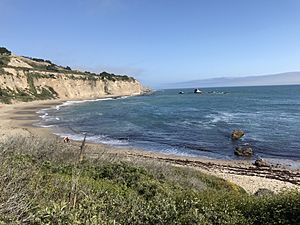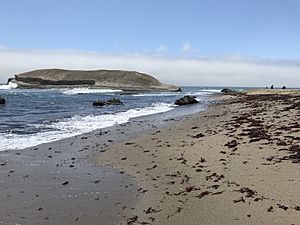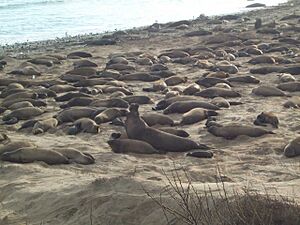Greyhound Rock State Marine Conservation Area facts for kids
The Greyhound Rock State Marine Conservation Area (SMCA) is a special ocean area off the coast of California. It's located near San Mateo and Santa Cruz counties, about 55 miles (88.5 km) south of San Francisco. This protected area covers about 11.81 square miles (30.59 km²). Think of it like a national park, but for the ocean! In this area, most fishing and taking of marine life is not allowed. However, people can still recreationally fish for certain types of finfish, salmon, and squid, and collect giant kelp under specific rules. Commercial fishing for salmon, squid, and giant kelp is also allowed with certain conditions. These rules help protect the ocean's amazing creatures and habitats.
Contents
How the Greyhound Rock SMCA Started
The Greyhound Rock State Marine Conservation Area was created in September 2007. It was set up by the California Department of Fish & Game, which is now called the California Department of Fish and Wildlife. This area was one of the first 29 marine protected areas established in California. These special ocean zones were created as part of the Marine Life Protection Act Initiative. This initiative is a big project where people work together to create a network of protected ocean areas all along California's coastline. The goal is to keep our oceans healthy for many years to come.
Where is the Greyhound Rock SMCA Located?
The Greyhound Rock SMCA is right next to Año Nuevo State Park, which is famous for its elephant seals. Another protected ocean area, the Año Nuevo State Marine Conservation Area, is just to the north of Greyhound Rock.
This marine protected area stretches from the coastline out into the ocean. It goes about 3 nautical miles (5.5 km) offshore. The boundaries of the area connect several specific points in the ocean. These points help define exactly where the protected zone begins and ends.
Amazing Animals and Habitats at Greyhound Rock
The waters around Point Año Nuevo, which is very close to the SMCA, are home to many different animals. Thousands of seabirds use this area for breeding. It's also a world-famous spot where many elephant seals come to rest and have their babies. These waters also attract great white sharks, and scientists have found "hotspots" here for certain fish like the canary rockfish, which are in danger. Even threatened marbled murrelets, a type of seabird, rest on shore and look for food in the calm waters near the point.
The Greyhound Rock SMCA offers many different types of homes for marine life. These include:
- Rocky areas along the shore where the tide goes in and out.
- Sandy beaches.
- Estuaries, which are places where rivers meet the sea.
- Offshore rocks and small islands.
- Shale reefs, which are underwater rock formations.
- Forests of bull kelp and giant kelp, which are like underwater trees providing shelter and food.
Fun Things to Do and See Nearby
The areas next to the Greyhound Rock SMCA, like Año Nuevo State Reserve and Año Nuevo State Park, offer many activities. They have special programs with guides who can lead tours, especially to see the elephant seal colony from December to March. There are also visitor centers, parking, and park rangers to help visitors and make sure rules are followed.
California's marine protected areas encourage people to enjoy and learn about the ocean. You can do activities like kayaking, diving, snorkeling, and swimming in these areas, unless there are specific rules against it.
You can easily get to the coast in the Greyhound Rock SMCA at places like Greyhound Rock Beach and the northern part of Scott's Creek Beach.
How Scientists Study the Ocean Here
Scientists are closely watching marine protected areas like Greyhound Rock SMCA. They want to see how well these areas are working to protect ocean health. For example, similar studies in protected areas near the Santa Barbara Channel Islands have already shown that fish are getting bigger and there are more of them. This means the protection is helping!
Many local universities and research centers are involved in this monitoring. These include Stanford University's Hopkins Marine Station, University of California Santa Cruz, Moss Landing Marine Laboratories, and Cal Poly San Luis Obispo. Scientists use different methods to study the ocean. They might use hook-and-line fishing to sample fish, explore the intertidal zone, or dive underwater with scuba gear. They also use special Remote Operated Vehicle (ROV) submarines to explore deeper parts of the ocean.




